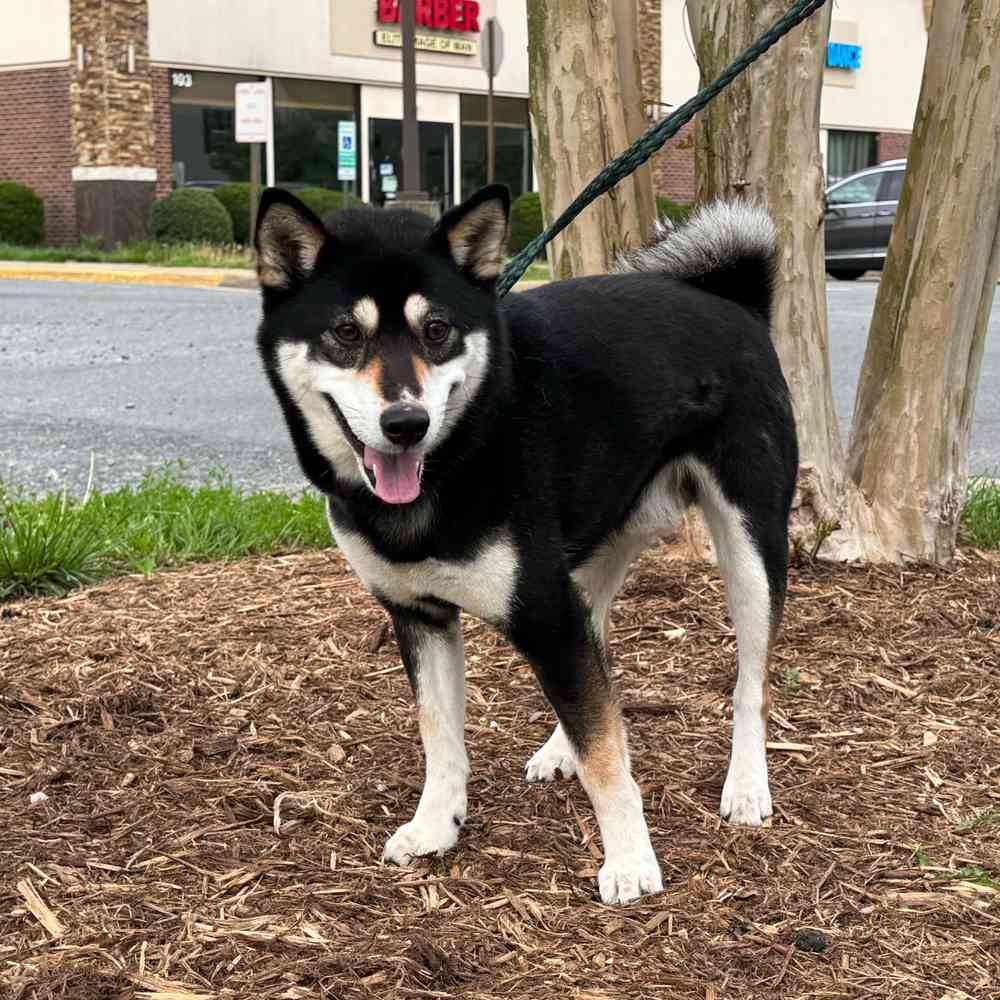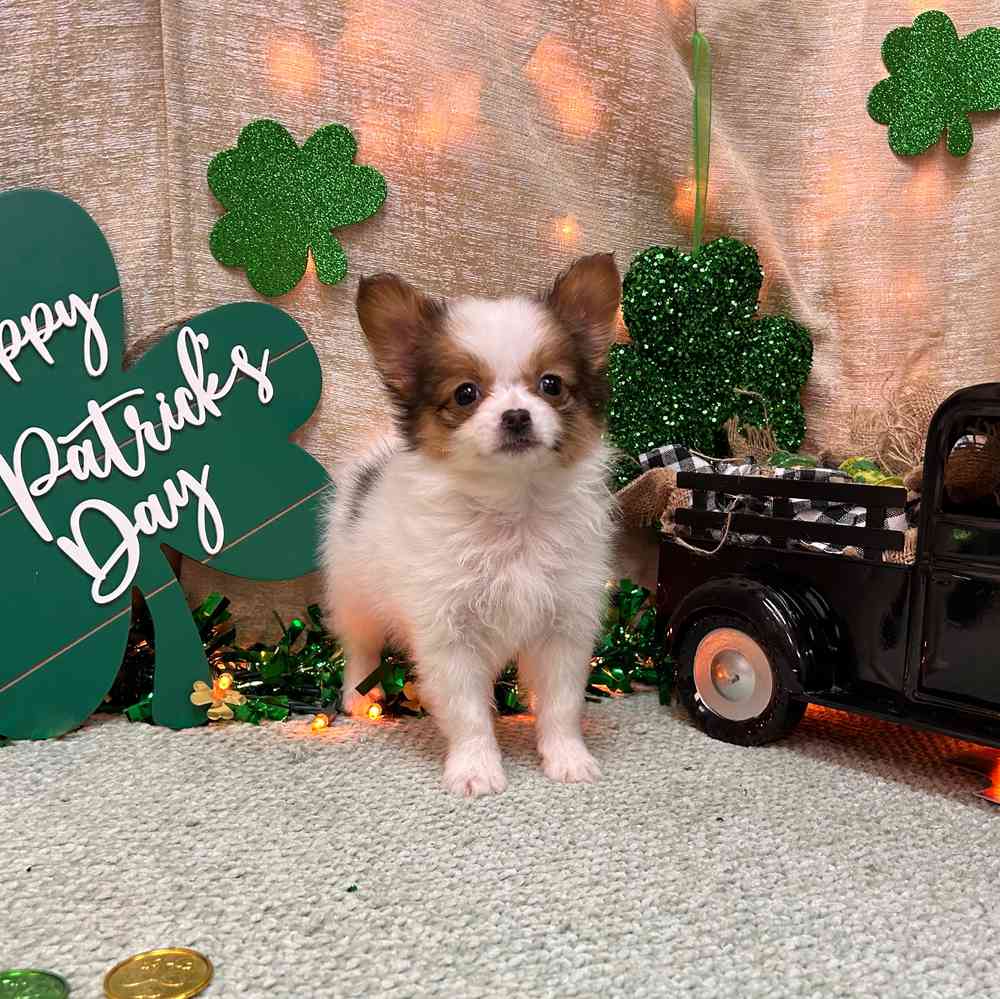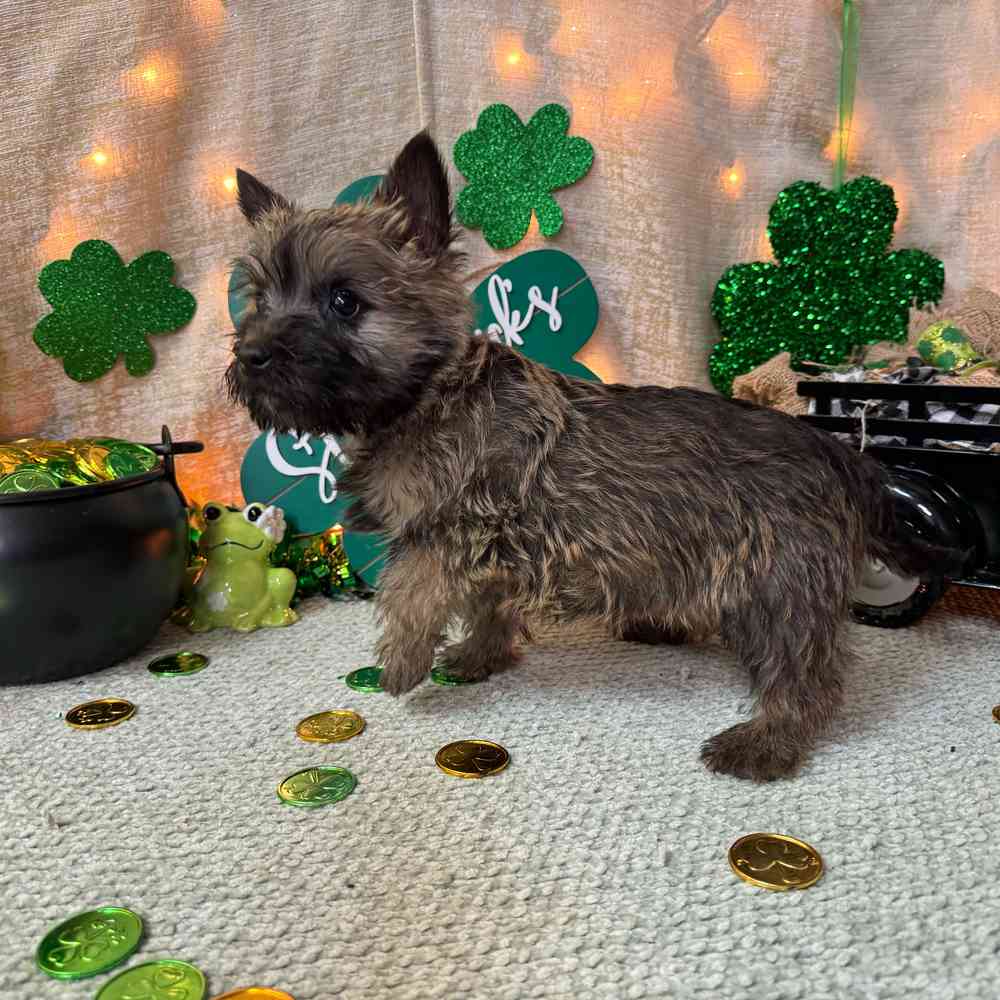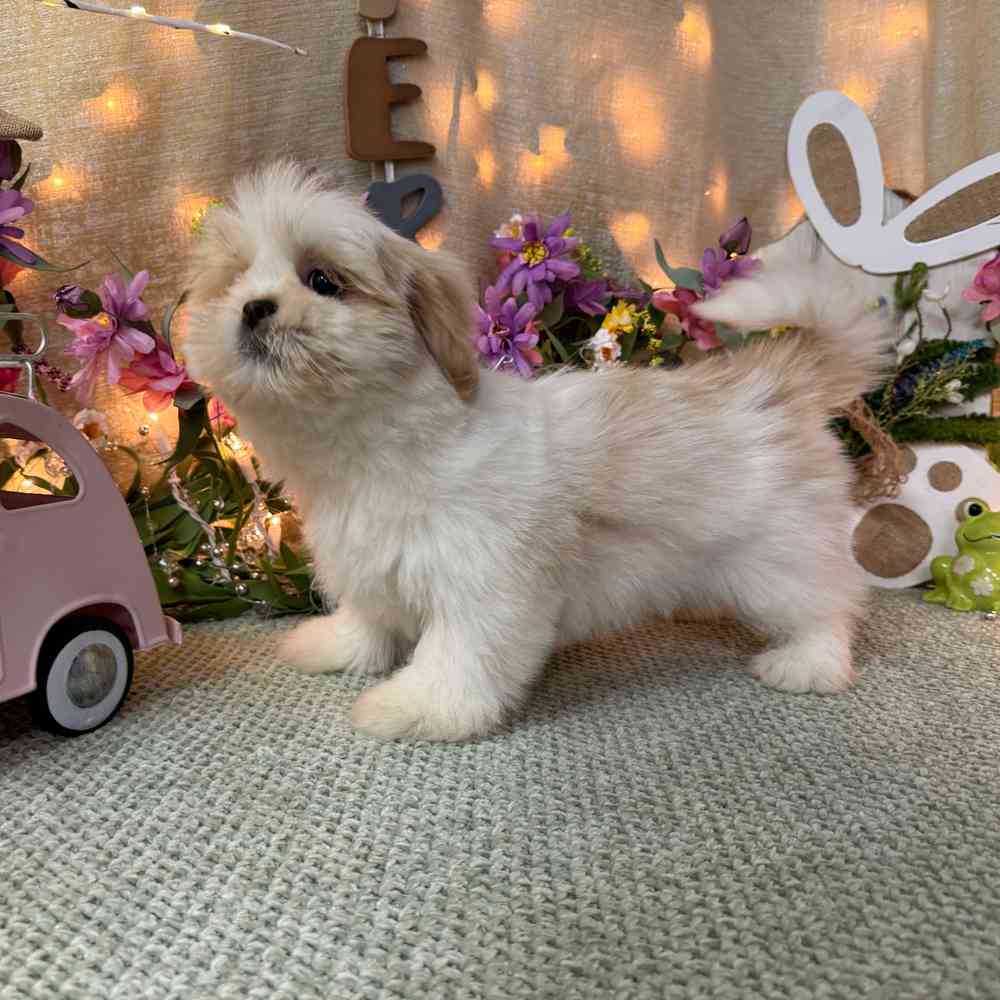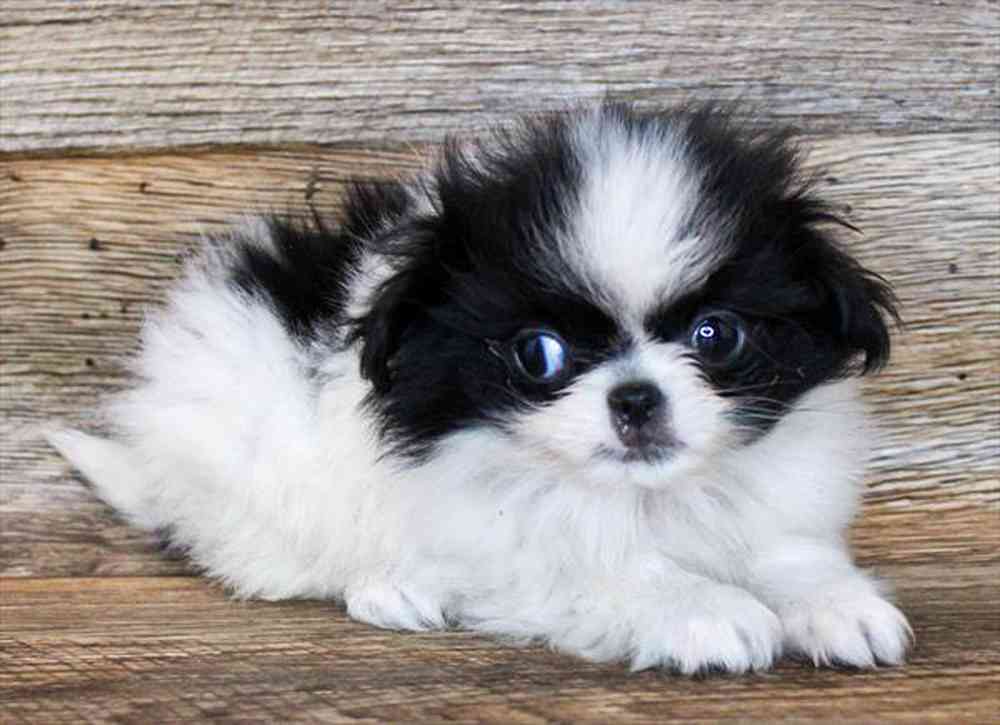
AKC Registrable
Japanese Chin
The Japanese Chin is a charming toy companion of silky, profuse coat and an unmistakably aristocratic bearing. Often described as a distinctly “feline” breed, this bright and amusing lapdog is fastidious, graceful, and generally quiet.
Available Pups
Puppy Knowledge
Breed Standard
General Appearance
The Japanese Chin is a small, well balanced, lively, aristocratic toy dog with a distinctive Oriental expression. It is light and stylish in action. The plumed tail is carried over the back, curving to either side. The coat is profuse, silky, soft and straight. The dog's outline presents a square appearance.
Size, Proportion, Substance
Size - Ideal size is 8 to 11 inches at the highest point of the withers. Proportion - Length between the sternum and the buttock is equal to the height at the withers. Substance - Solidly built, compact, yet refined. Carrying good weight in proportion to height and body build.
Head
Expression - bright, inquisitive, alert, and intelligent. The distinctive Oriental expression is characterized by the large broad head, large wide-set eyes, short broad muzzle, ear feathering, and the evenly patterned facial markings. Eyes - set wide apart, large, round, dark in color, and lustrous. A small amount of white showing in the inner corners of the eyes is a breed characteristic that gives the dog a look of astonishment. Ears - hanging, small, V-shaped, wide apart, set slightly below the crown of the skull. When alert, the ears are carried forward and downward. The ears are well feathered and fit into the rounded contour of the head. Skull - large, broad, slightly rounded between the ears but not domed. Forehead is prominent, rounding toward the nose. Wide across the level of the eyes. In profile, the forehead and muzzle touch on the same vertical plane of a right angle whose horizontal plane is the top of the skull. Stop - deep. Muzzle - short and broad with well-cushioned cheeks and rounded upper lips that cover the teeth. Nose - very short with wide, open nostrils. Set on a level with the middle of the eyes and upturned. Nose leather is black in the black and white and the black and white with tan points, and is self-colored or black in the red and white. Bite - The jaw is wide and slightly undershot. A dog with one or two missing or slightly misaligned teeth should not be severely penalized. The Japanese Chin is very sensitive to oral examination. If the dog displays any hesitancy, judges are asked to defer to the handler for presentation of the bite.
Neck, Topline, Body
Neck - moderate in length and thickness. Well set on the shoulders enabling the dog to carry its head up proudly. Topline - level. Body - square, moderately wide in the chest with rounded ribs. Depth of rib extends to the elbow. Tail - set on high, carried arched up over the back and flowing to either side of the body.
Forequarters
Legs - straight, and fine boned, with the elbows set close to the body. Removal of dewclaws is optional. Feet - hare-shaped with feathering on the ends of the toes in the mature dog. Point straight ahead or very slightly outward.
Hindquarters
Legs - straight as viewed from the rear and fine boned. Moderate bend of stifle. Removal of dewclaws is optional. Feet - hare-shaped with feathering on the ends of the toes in the mature dog. Point straight ahead.
Coat
Abundant, straight, single, and silky. Has a resilient texture and a tendency to stand out from the body, especially on neck, shoulders, and chest areas where the hair forms a thick mane or ruff. The tail is profusely coated and forms a plume. The rump area is heavily coated and forms culottes or pants. The head and muzzle are covered with short hair except for the heavily feathered ears. The forelegs have short hair blending into profuse feathering on the backs of the legs. The rear legs have the previously described culottes, and in mature dogs, light feathering from hock joint to the foot.
Color
Either black and white, red and white, or black and white with tan points. The term tan points shall include tan or red spots over each eye, inside the ears, on both cheeks, and at the anal vent area if displaying any black. The term red shall include all shades of red, orange, and lemon, and sable, which includes any aforementioned shade intermingled or overlaid with black. Among the allowed colors there shall be no preference when judging. A clearly defined white muzzle and blaze are preferable to a solidly marked head. Symmetry of facial markings is preferable. The size, shape, placement or number of body patches is not of great importance. The white is clear of excessive ticking. Disqualification - any color not listed.
Gait
Stylish and lively in movement. Moves straight with front and rear legs following in the same plane.
Temperament
Charming, Noble, Loving
Disqualifications
Any color not listed.
Overview
Group
Toy
About
Chin are the unrivaled noblemen of Japanese breeds. They’re tiny “indoorsy” companions, with an unmistakably Eastern look and bearing. The head is large, the muzzle short, and the round, dark eyes convey, as Chin fans like to say, a “look of astonishment.” The profuse mane around the neck and shoulders, the plumed tail arching over the back, and the pants or “culottes” on the hind legs project the elegant, exotic appearance so typical of Asia’s royal line of laptop cuddle bugs.
History
That’s a good question. Historians have long debated the breed’s beginnings. Some maintain it was a product of China; others say Korea. Various origin tales credit Buddhist monks, Chinese emperors, or European merchants with the Chin’s introduction to Japan anywhere from 500 to 1,000 years ago. But all agree that it was Japanese nobles who cultivated the breed as we know it today. Chin were unknown in the West until 1854, when Japan was reopened for trade after 200 years of isolation.
Standard
The Japanese Chin is a small, well balanced, lively, aristocratic toy dog with a distinctive Oriental expression. It is light and stylish in action. The plumed tail is carried over the back, curving to either side. The coat is profuse, silky, soft and straight. The dog’s outline presents a square appearance.
Nutrition
The Japanese Chin should do well on a high-quality dog food, whether commercially manufactured or home-prepared with your veterinarian’s supervision and approval. Any diet should be appropriate to the dog’s age (puppy, adult, or senior). Some dogs are prone to getting overweight, so watch your dog’s calorie consumption and weight level. Treats can be an important aid in training, but giving too many can cause obesity. Learn about which human foods are safe for dogs, and which are not. Check with your vet if you have any concerns about your dog’s weight or diet. Clean, fresh water should be available at all times.
Grooming
The long, silky coat of the Japanese Chin gives him the appearance of a high-maintenance breed, but he is surprisingly easy to maintain in top condition. He will require weekly brushing and a bath once a month or so, depending on his surroundings. The breed’s nails grow very fast and should be trimmed regularly to keep them short and neat. Their ears should be checked regularly to avoid a buildup of wax and debris that can cause ear infections, and teeth should be brushed regularly to avoid dental problems.
Exercise
The Japanese Chin is a fairly active little dog. He will enjoy going for slow walks with his humans, or exploring his fenced backyard. The breed is an excellent choice for apartment living. Because of their stubborn nature, it is never a good idea to allow them to outdoors off lead. If they see something they want to explore, they are likely to refuse to listen to any commands or pleas. They are a bit reserved around new people, pets, and situations, but with proper socialization will enjoy going for romps in a supervised dog park with other small dogs.
Training
Training a Chin can be simple for the trainer who can make them believe they are doing only the things they want to do. Bred strictly as companions for royalty, the Chin’s only job throughout the breed’s history has been to charm, amuse, and comfort their humans. They are often referred to as “catlike,” and this trait can certainly be visible during training. They react well to positive training methods, but will shut down at the first hint of harshness. Training sessions must be interesting and fun to keep their attention. They love to learn tricks to perform for their adoring public.
Health
The Japanese Chin is a generally healthy breed, and responsible breeders screen for health concerns such as luxating patellas (slipping kneecaps), cataracts, epilepsy, and early-onset heart murmurs. Japanese Chin can be affected by a fatal neurological condition called GM2 gangliosidosis, or Tay-Sachs disease; using a DNA test, breeders can identify carriers and plan breedings to prevent the disease from manifesting in their puppies.

